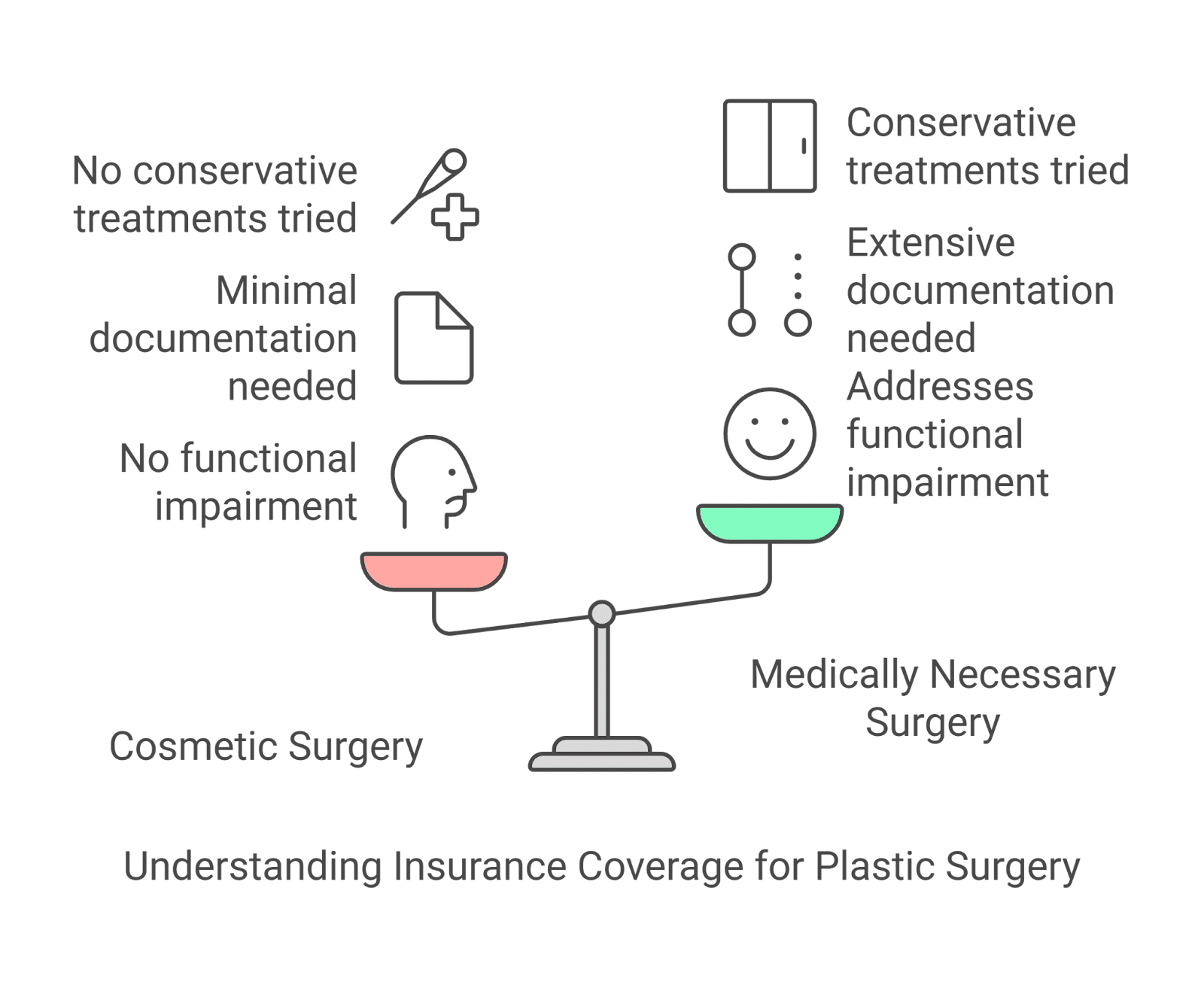Plastic Surgery Insurance Coverage includes both cosmetic procedures and essential reconstructive surgeries. Patients commonly inquire about the possibility of health insurance covering plastic surgery costs. Insurance coverage of a procedure depends on its classification as either cosmetic or medically necessary.
The article will differentiate cosmetic from reconstructive procedures and examine which plastic surgeries health insurance covers while explaining how insurance companies determine coverage eligibility. PEO4YOU provides vital information to people seeking health insurance coverage who want to understand the policies associated with plastic surgery.
Understanding Cosmetic vs. Reconstructive Surgery
Plastic Surgery Insurance Coverage can be broadly classified into two categories: cosmetic surgery and reconstructive surgery.
- Cosmetic Surgery: Cosmetic procedures aim to change physical appearance rather than address medical conditions. Cosmetic surgeries include aesthetic procedures such as facelifts liposuction rhinoplasty and breast augmentations except those needed for medical reasons. Elective procedures remain uncovered by health insurance because they do not deliver medical treatment benefits.
- Reconstructive Surgery: Medical professionals conduct these surgical procedures to correct abnormalities caused by congenital defects or by trauma infections tumors and diseases. This procedure aims to restore normal function while providing aesthetic improvements. Surgeries that repair traumatic injuries alongside post-mastectomy breast reconstruction and cleft lip and palate repair represent common reconstructive surgical procedures. When procedures are considered medically necessary plastic surgery insurance coverage includes these treatments.
Medical professionals must recognize the difference between the two categories to identify which procedures will receive insurance coverage.

Are Reconstructive Surgeries, Such as Post-Mastectomy Breast Reconstruction, Always Covered by Insurance?
Breast reconstruction becomes a vital step in recovery for breast cancer patients who undergo mastectomy. The Women’s Health and Cancer Rights Act (WHCRA) of 1998 requires insurance companies to provide coverage for breast reconstruction after mastectomy. This includes:
- Surgical reconstruction of the affected breast will restore its original shape.
- The surgical procedure on the non-affected breast aims to achieve symmetry between both breasts.
- Prostheses and treatment for complications, including lymphedema
Despite federal law requiring plastic surgery insurance coverage some companies may limit their coverage to specific reconstruction procedures or set time limits for when surgery must occur. Patients must consult their insurance provider to understand their coverage details before they undergo surgery.
What Types of Plastic Surgeries Are Typically Covered by Health Insurance?
Although most cosmetic procedures do not receive health insurance coverage plastic surgeries deemed medically necessary often receive full or partial coverage. Below are some common examples:
1. Breast Reduction (Reduction Mammaplasty)
Health insurance may cover breast reduction surgery when excessive breast tissue leads to medical conditions like:
- Chronic back, neck, or shoulder pain
- Breast reduction surgery may receive insurance coverage when the skin develops problems like rashes or infections beneath the breasts.
- Posture problems
- Nerve pain
Healthcare provider documentation is necessary to show insurance companies that medical issues continue to exist even after trying non-surgical solutions like physical therapy and pain medication.
2. Eyelid Surgery (Blepharoplasty)
Patients typically undergo eyelid surgery to improve appearance; however, when eyelid droop affects sight it becomes a medically essential procedure. Obtaining insurance coverage for plastic surgery requires proof of medical necessity through various forms of documentation.
- Visual field tests showing obstruction
- Photographs demonstrating eyelid drooping
- A physician’s statement supporting the medical need
3. Nose Surgery (Rhinoplasty and Septoplasty)
Rhinoplasty surgery is often performed for beauty improvements but it also provides essential medical benefits. A medical insurance plan might fund the surgery when it resolves specific health issues.
- A deviated septum that obstructs airflow (septoplasty)
- Chronic sinus infections
- Structural abnormalities or injuries can create breathing difficulties that require medical intervention.
4. Reconstructive Hand Surgery
Plastic surgery insurance coverage normally includes surgical procedures that restore hand function including those for carpal tunnel syndrome correction and rheumatoid arthritis deformity repair.
5. Skin Cancer Removal and Reconstruction
Plastic surgery insurance frequently covers reconstructive procedures like skin grafts or flap surgery when they follow skin cancer removal surgery.
6. Gender-Affirming Surgeries
Gender-affirming medical procedures receive coverage from numerous health insurance plans when they fulfill medical necessity criteria for transgender patients. Plastic surgery insurance coverage typically includes chest reconstruction in addition to facial feminization and genital reconstruction surgeries.
How Do Insurance Companies Differentiate Between Cosmetic and Medically Necessary Plastic Surgery?
Insurance providers apply rigorous standards to assess if a plastic surgery operation meets medical necessity requirements. Some factors they consider include:
- Functional Impairment: Procedures that resolve medical conditions affecting bodily functions (e.g., vision obstruction, chronic pain, breathing difficulties) stand a better chance of receiving insurance coverage.
- Medical Documentation: Medical records from doctors outlining symptoms and diagnoses and documentation of non-surgical treatments that failed are necessary for patients to submit.
- Conservative Treatments: Insurance policies mandate that patients explore non-surgical options like physical therapy or medication before granting surgery approval.
- Photographic Evidence: Insurance companies sometimes require patients to provide photographs as proof that their procedure is medically necessary.
- Pre-Authorization: Patients must obtain pre-authorization from their insurance providers before undergoing reconstructive surgeries to assess eligibility for Plastic Surgery Insurance Coverage.
All insurance providers follow different rules which requires patients to review their specific insurance plan details and work with their doctors for proper documentation.

Plastic Surgery Insurance Coverage: Navigating Your Options with Expert Guidance
Multiple aspects make it difficult to understand insurance coverage when it comes to plastic surgery. Patients must differentiate between cosmetic procedures and reconstructive procedures while acquiring the necessary documentation and working with their insurer to determine coverage eligibility.
PEO4YOU delivers essential assistance to people seeking appropriate healthcare insurance coverage options. PEO4YOU facilitates connections between clients and health insurance companies to help individuals and families along with businesses choose healthcare plans that align with their unique needs. Their services include:
- Helping clients compare different health insurance plans
- Identifying policies that cover reconstructive procedures
- PEO4YOU assists clients with navigating the process of obtaining Plastic Surgery Insurance Coverage claims and approvals.
PEO4YOU assists people to locate suitable insurance plans which cover medically necessary plastic surgery and helps understand current coverage through their connection services. Learn more about PEO4YOU’s assistance services by visiting their website.


